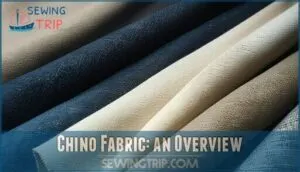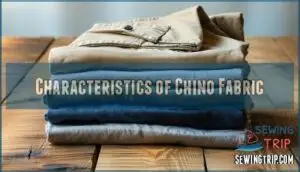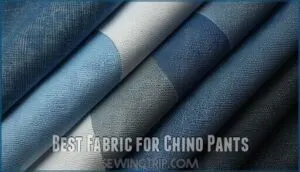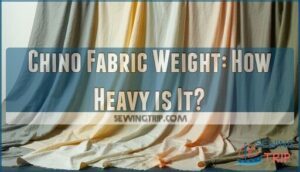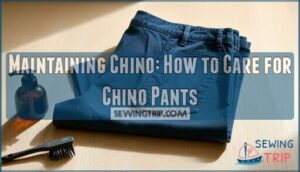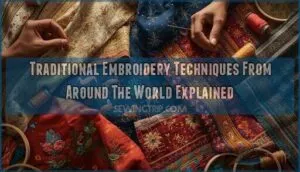This site is supported by our readers. We may earn a commission, at no cost to you, if you purchase through links.
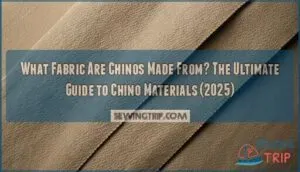 Chinos are typically made from cotton twill fabric, a durable material with a distinctive diagonal weave pattern.
Chinos are typically made from cotton twill fabric, a durable material with a distinctive diagonal weave pattern.
You’ll find most quality chinos use 100% cotton, though modern versions often incorporate synthetic fibers like polyester or elastane (spandex) for stretch and wrinkle resistance.
The cotton twill gives chinos their characteristic medium weight, breathability, and slight sheen that distinguishes them from both jeans and dress pants.
This versatile fabric takes dye well, which explains the wide range of colors available, and the best chinos balance comfort with structure, maintaining their shape while adapting to your body throughout the day.
Table Of Contents
- Key Takeaways
- Chino Fabric: an Overview
- Characteristics of Chino Fabric
- What is Chino Fabric Made From?
- Best Fabric for Chino Pants
- Chino Fabric Weight: How Heavy is It?
- Chino Fabric Price: How Much Does It Cost?
- Chino Fabric Vs Denim: What’s The Difference?
- Maintaining Chino: How to Care for Chino Pants
- Frequently Asked Questions (FAQs)
- Conclusion
Key Takeaways
- You’ll find that traditional chinos are made from 100% cotton twill fabric, characterized by its distinctive diagonal weave pattern that provides both durability and a slight sheen.
- Modern chino variations often incorporate synthetic fibers like elastane (2-3%) or polyester to enhance stretch and comfort, while maintaining the classic look.
- Chino fabric typically weighs between 7-10 ounces per yard, striking the perfect balance between structure and comfort for versatile wear across seasons.
- You can maintain your chinos’ crisp appearance by washing them in cold water (turned inside out), treating stains immediately, and air drying or tumble drying on low heat to prevent shrinkage.
Chino Fabric: an Overview
Anyone familiar with chinos appreciates their perfect balance of comfort and durability.
Chino fabric originated as a military staple, crafted from 100% cotton in a distinctive twill weave that creates those subtle diagonal lines you’ll notice on closer inspection.
The fabric’s weave density contributes to its remarkable strength while maintaining breathability—a combination that’s hard to beat.
Remarkable weave density strikes the perfect balance, delivering unmatched strength and breathability in every versatile piece of chino fabric.
Modern adaptations now include various fiber blends incorporating elastane or polyester, enhancing the traditional cotton base.
Manufacturers typically mercerize chino cloth to add that slight sheen and extra resilience you’ve come to expect.
**Some chinos utilize durable twill fabrics for enhanced longevity.
What makes chino fabric so versatile is its medium weight and smooth finish.
Whether you’re heading to a casual Friday meeting or weekend brunch, chinos provide that sweet spot between jeans and dress pants—not too formal, never too casual.
Characteristics of Chino Fabric
You’ll find that chino fabric combines durability, breathability, absorbency, and excellent drape in one versatile package.
These characteristics explain why chinos have successfully evolved from military uniforms to everyday wardrobe essentials that work in nearly any setting, making them a great example of versatile clothing.
Durability
Every chino fabric delivers exceptional durability thanks to its distinctive twill weave construction.
The tightly woven cotton twill creates natural abrasion resistance, allowing your pants to withstand daily wear without pilling. This durable fabric stands up to countless washes while maintaining its shape and color.
The blend strength in modern chinos combines cotton’s natural toughness with synthetic fibers for enhanced tear resistance. You’ll notice how chino cloth outperforms many alternatives, especially at stress points like knees and pockets.
With proper care, this resilient fabric guarantees long-lasting wear – many quality pairs can serve you reliably for years, providing exceptional abrasion resistance and maintaining its original shape, making it a great choice due to its overall toughness.
Breathability
Building on chino’s remarkable durability, their breathability stands as another key advantage.
The cotton twill weave allows air to circulate freely against your skin, preventing that uncomfortable sticky feeling during warmer weather.
Chino fabric’s exceptional breathability comes from:
- Natural cotton fibers that allow air exchange
- Strategic twill weave creating microscopic ventilation channels
- Lightweight construction (7-10 oz/yard) enhancing airflow
- Moisture-wicking properties that pull sweat away from your body.
You’ll appreciate this breathable fabric most during summer activities or in humid environments.
Absorbency
The impressive absorbency of chino fabric stems from its cotton construction, allowing it to absorb up to 65% of its weight in moisture.
This natural fiber absorbency keeps you dry during warmer days while maintaining breathability.
Absorbency testing shows chino fabric outperforms many synthetic alternatives, though it does have a longer drying time compared to moisture-wicking technical fabrics.
The weave structure and fiber composition are key absorbency factors that influence performance. While chinos don’t replace specialized activewear, their ability to manage everyday moisture makes them comfortable for regular wear in various conditions.
Drapability
Beyond absorbing moisture effectively, chino fabric offers remarkable drapability that enhances its appeal.
The cotton twill construction allows the fabric to flow naturally over your body, creating a clean clothing silhouette without clinging.
You’ll notice how chino fabric moves with you rather than against you, maintaining its aesthetic appeal throughout wear.
The mercerization process gives the material a subtle sheen while improving wrinkle resistance.
This fabric softness isn’t just comfortable—it’s practical, allowing pants to hang properly without awkward bunching.
The natural drape of chino fabric makes it versatile enough for both casual Friday and weekend outings, providing a clean clothing silhouette.
What is Chino Fabric Made From?
Now that we’ve examined the standout characteristics of chino fabric, let’s look at what actually goes into making this versatile material.
Chino fabric is primarily crafted from 100% cotton twill, distinguished by its diagonal weave pattern that gives it both strength and a distinctive texture.
Here’s what makes up traditional chino material:
- Cotton twill serves as the foundation, with fibers woven in a diagonal pattern
- Mercerization process enhances the cotton fabric’s strength and adds a subtle sheen
- Synthetic blends often incorporate elastane or polyester for stretch and durability
- Sustainable chinos made from organic cotton or recycled materials are gaining popularity
The weave types vary, but the steep twill construction remains consistent across chino varieties, creating that perfect balance between durability and comfort you’ve come to expect.
Best Fabric for Chino Pants
While durability meets style in high-quality chino pants, choosing the right fabric dramatically impacts your comfort and satisfaction.
Cotton twill remains the gold standard for chino material, offering the perfect balance of breathability and strength that has made these pants a wardrobe staple since their military origins.
When selecting chino fabric, consider these key options:
- 100% cotton twill for maximum breathability and classic feel
- Cotton-elastane blends (2-3% elastane) for enhanced movement and comfort
- Cotton-polyester blends for improved wrinkle resistance and longevity
- Organic cotton options for environmentally-conscious consumers
The best chino material features a medium-weight cotton twill with a distinctive diagonal weave pattern that provides structure without stiffness.
Look for mercerized finishes that add subtle sheen and improved durability.
Modern weave variations include herringbone and basketweave patterns that maintain the essential chino character while offering visual interest.
For all-season wear, opt for midweight (8-9oz) fabric that shifts well between seasons.
Chino Fabric Weight: How Heavy is It?
For everyday wear, chino fabric weight typically ranges from 7-10 ounces per yard, striking a perfect balance between durability and comfort. This midweight construction offers versatility across seasons while maintaining the classic chino look you love.
Understanding fabric weight helps you choose the right chinos for your needs:
- Lightweight chinos (under 7 oz) provide excellent breathability for summer months
- Midweight options (7-9 oz) offer year-round versatility with good drape
- Heavyweight chinos (10+ oz) provide structure and warmth for winter wear
- Activity-specific weights determine performance (lighter for active use, heavier for formal settings)
The fabric weight impact extends beyond comfort to affect how your chinos drape on your body. Cotton fabric weight variations allow manufacturers to create seasonal collections that maintain breathability while adjusting thickness for temperature regulation—making chinos truly adaptable bottoms for your wardrobe.
Chino Fabric Price: How Much Does It Cost?
After considering the weight of chino fabric, let’s look at what you’ll pay for it. Chino fabric prices vary widely depending on quality and source.
You can find options ranging from $5 per half-yard to over $100 for premium selections. When shopping for chino fabric, consider these cost factors:
- Material composition (100% cotton typically costs more than blends)
- Fabric weight (heavier fabrics often command higher prices)
- Brand reputation (established textile brands charge premium rates)
- Purchase quantity (bulk buying can reduce per-yard costs substantially)
Mood Fabrics offers cotton chino fabric from under $25 to over $100 per yard, while wholesale prices can be as low as $1 per yard. Standard shipping typically costs around $9.99, with many retailers offering free shipping on larger orders.
Chino Fabric Vs Denim: What’s The Difference?
When comparing chino fabric to denim, you’ll notice several key differences in how they feel and function in your wardrobe. While both are durable cotton fabrics, they serve different purposes and occasions.
| Feature | Chino Fabric | Denim |
|---|---|---|
| Weave comparison | Twill weave with finer diagonal lines | Twill weave with more pronounced diagonal pattern |
| Fabric weight | Lighter (7-10 oz per yard) | Heavier (12-16 oz per yard) |
| Seasonal wear | Versatile, better for warm weather | Primarily fall/winter, can be hot |
| Styling differences | Business casual to smart casual | Casual to street style |
Chinos offer more breathability than denim, making them ideal for spring and summer. The cotton twill construction creates a smoother texture that’s less rigid than denim’s rugged feel. While jeans might be your go-to for durability, modern chinos have impressive longevity without the break-in period denim requires.
Denim, on the other hand, often features a more rugged texture, which can be a key factor in choosing between chino and denim for specific occasions, considering factors like seasonal wear and styling differences.
Maintaining Chino: How to Care for Chino Pants
While denim demands rugged care, your chino pants require gentle attention to maintain their crisp appearance.
Proper maintenance extends the life of your cotton twill treasures.
- Turn chinos inside out before washing in cold water to preserve color and prevent fabric abrasion
- Treat stains immediately with a mild soap solution, gently blotting rather than rubbing
- Air dry or tumble dry on low heat to avoid shrinkage of the cotton fabric
- Iron on medium heat while slightly damp for a crisp finish
- Store hanging to prevent creases and maintain the fabric’s natural drape
To keep them looking their best, consider specialized cleaning products for optimal care.
Frequently Asked Questions (FAQs)
What makes up chino cloth?
In ye olden days, chino cloth was primarily made from 100% cotton twill fabric. You’ll find modern versions often include blends with elastane or polyester for added stretch and durability.
What are chinos made of?
Chinos are typically made from 100% cotton twill fabric. You’ll find modern versions often blend cotton with materials like polyester, elastane, or spandex for added durability, stretch, and wrinkle resistance.
What is the best fabric for chinos?
The absolute best fabric for chinos you’ll ever find is cotton twill.
You’ll appreciate its breathability and durability, while blends with elastane offer stretch for comfort.
Merino wool and bamboo provide excellent temperature regulation.
What are Chino pants made of?
You’ll find traditional chinos made from 100% cotton twill fabric, which offers durability and comfort. Many modern versions incorporate blends with elastane for stretch or polyester for wrinkle resistance and longevity.
What are the features of chino fabric?
Cotton twill fabric can absorb up to 65% of its weight in moisture before dripping.
You’ll appreciate chino fabric’s durability, breathability, soft texture, and diagonal weave pattern that gives it a distinctive look.
Where did chino fabric come from?
The fabric originated during the Spanish-American War from China-made cotton twill.
You’ll find it’s named "chino" from Spanish slang for "China."
It was initially designed for military uniforms in the Philippines.
How Often Should I Wash My Chino Pants?
Want your chinos to last longer? Wash them after 3-5 wears unless they’re visibly dirty or smelly. You can spot clean minor stains instead of machine washing every time.
Are Chinos Suitable for Hot Weather?
Yes, chinos are excellent for hot weather.
Their lightweight cotton twill fabric breathes well and wicks moisture from your skin.
You’ll stay cool and comfortable while maintaining a polished appearance all day long.
Are Chinos Available in Different Styles?
With over 250 variations available today, chinos come in slim-fit, straight-leg, pleated, flat-front, tapered, and relaxed styles. You’ll find options for every body type and fashion preference.
What Colors Are Available for Chino Pants?
You’ll find chinos in classic neutrals like khaki, navy, and olive, plus modern options including burgundy, mustard, and pastel shades.
Many retailers offer seasonal colors to keep your wardrobe fresh and versatile.
Conclusion
Just as a chameleon adapts to its surroundings, your chinos adapt to your life—thanks to their unique fabric composition.
Now you know what fabric chinos are made from: primarily cotton twill, sometimes blended with synthetics for enhanced performance.
Whether you’re dressing up or down, these versatile pants offer the perfect balance of comfort, durability, and style.
Choose your chinos wisely, care for them properly, and they’ll remain wardrobe staples for years to come.

